Study on Stability and Ecological Restoration of Soil-Covered Rocky Slope of an Abandoned Mine on an Island in Rainy Regions
Abstract
:1. Introduction
2. The Study Area
2.1. The Location and Overview of the Study Area
2.2. Geological Characteristics and Disaster Analyses
2.3. Meteorological and Hydrological Conditions
3. Materials and Methods
3.1. Ecological Restoration Plan for the Abandoned Mine
3.1.1. Plant Habitat Restoration
- (1)
- Slope cutting and cleaning. The slopes in Zone A, B, and C shall be cut according to the terrain with the principle of minimum workload, and the dangerous rock body shall be removed. Because most of the slope is angled at about 45°, to reduce the quantities it shall be designed according to a 45° slope cutting, and a step shall be added in the middle. The slope foot shall be leveled with slag.
- (2)
- According to the existing research results [33], a certain thickness of soil helps to improve the structure and stability of soil aggregates. Covering the planting soil with a thickness of more than 60 cm can basically meet the growth needs of various plants. Therefore, when repairing the mine slope, it is required that the covering thickness of the planting soil should not be less than 50 cm, and the thickness of the spray mixed planting material should not be less than 15 cm.
- (3)
- The ecological retaining wall is built with on-site block stones 2.0 m outside the foot line of the upstream slope with a design length of 110 m. The stone shall be hard and not easily weatherable. The upper and lower surfaces are roughly flat, with a thickness of no less than 20 cm and a strength grade of at least MU 30. Its foundation is 0.3 m deep, 1.0 m wide, 1.0 m high, 0.6 m wide at the top, and 0.8 m wide at the bottom.
3.1.2. Plant Selection and Construction Technology
3.2. Stability Analyses of the Plant Habitat
3.2.1. Transient Seepage Equation of Saturated-Unsaturated Soil
3.2.2. Stability Calculation Model
3.2.3. Calculation Parameters
- (1)
- Geometric parameters
- (2)
- Basic properties of the rock and soil mass
- (3)
- Hydraulic parameters
3.2.4. Boundary Conditions
- (1)
- Hydraulic boundary conditions
- (2)
- Stress/Strain boundary conditions
4. Results and Discussions
4.1. Stability of the Soil Covered Slope
4.2. Soil-Covered Slope Reinforcement and Ecological Restoration Measures
4.3. Ecological Restoration Effect of the Soil-Covered Slope
5. Conclusions
Author Contributions
Funding
Acknowledgments
Conflicts of Interest
References
- Visser Jenneke, M.; Duke-Sylvester Scott, M. LaVegMod v2: Modeling coastal vegetation dynamics in response to proposed coastal restoration and protection projects in Louisiana, USA. Sustainability 2017, 9, 1625. [Google Scholar] [CrossRef] [Green Version]
- Barnaud, G.; Chapuis, J.L. Scientific and ethic issues on the restoration of island ecosystems. The eradication of introduced mammals in the Subantarctic islands. Vie Milieu-Life Environ. 1996, 46, 291–303. [Google Scholar]
- Neghme, C.; Santamaria, L.; Calvino-Cancela, M. Strong dependence of a pioneer shrub on seed dispersal services provided by an endemic endangered lizard in a Mediterranean island ecosystem. PLoS ONE 2017, 12, e0183072. [Google Scholar] [CrossRef] [PubMed] [Green Version]
- Li, X.; Shen, T.; Zhang, H.; Shen, J.; Sun, W. Study on Ecological Restoration Technology of uninhabited island in Zhoushan: A case study of ecological restoration in quarry area of Zhoujiayuan Mountain. Yangtze River 2020, 51, 53–56. (In Chinese) [Google Scholar]
- Otto, R.; Barone, R.; Delgado, J.-D.; Arevalo, J.-R.; Garzon-Machado, V.; Cabrera-Rodriguez, F.; Fernandez-Palacios, J.-M. Diversity and distribution of the last remnants of endemic juniper woodlands on Tenerife, Canary Islands. Biodivers. Conserv. 2012, 21, 1811–1834. [Google Scholar] [CrossRef]
- Buxton, R.T.; Jones, C.J.; Lyver PO, B.; Towns, D.R.; Borrelle, S.B. Deciding when to lend a helping hand: A decision-making framework for seabird island restoration. Biodivers. Conserv. 2016, 25, 467–484. [Google Scholar] [CrossRef]
- Bai, J.G.; Wang, J.J.; Zhang, Y.L.; Ji, X.D.; Wen, N. Decision analysis of slope ecological restoration based on AHP. Sains Malays. 2017, 46, 2075–2081. [Google Scholar] [CrossRef] [Green Version]
- Liu, X.; Zhou, W.; Bai, Z. Vegetation coverage change and stability in large open-pit coal mine dumps in China during 1990–2015. Ecol. Eng. 2016, 95, 447–451. [Google Scholar] [CrossRef]
- Wang, J.; Schweizer, D.; Liu, Q.; Su, A.; Hu, X.; Blum, P. Three-dimensional landslide evolution model at the Yangtze River. Eng. Geol. 2021, 292, 106275. [Google Scholar] [CrossRef]
- da Silva, A.C.; Resende, I.; da Costa, R.C.; Uagoda, R.E.S.; de Souza Avelar, A. Geophysical for granitic joint patern and subsurface hydrology related to slope instability. J. Appl. Geophys. 2022, 199, 104607. [Google Scholar] [CrossRef]
- Marino, P.; Comegna, L.; Damiano, E.; Olivares, L.; Greco, R. Monitoring the Hydrological Balance of a Landslide-Prone Slope Covered by Pyroclastic Deposits over Limestone Fractured Bedrock. Water 2020, 12, 3309. [Google Scholar] [CrossRef]
- Marino, P.; Santonastaso, G.F.; Fan, X.; Greco, R. Prediction of shallow landslides in pyroclastic-covered slopes by coupled modeling of unsaturated and saturated groundwater flow. Landslides 2020, 18, 31–41. [Google Scholar] [CrossRef]
- Song, Z.; Li, X.; Lizárraga, J.J.; Zhao, L.; Buscarnera, G. Spatially distributed landslide triggering analyses accounting for coupled infiltration and volume change. Landslides 2020, 17, 2811–2824. [Google Scholar] [CrossRef]
- Damiano, E.; Greco, R.; Guida, A.; Olivares, L.; Picarelli, L. Investigation on rainwater infiltration into layered shallow covers in pyroclastic soils and its effect on slope stability. Eng. Geol. 2017, 220, 208–218. [Google Scholar] [CrossRef]
- Wang, M.; Liu, Q.; Pang, X. Evaluating ecological effects of roadside slope restoration techniques: A global meta-analysis. J. Environ. Manag. 2021, 281, 111867. [Google Scholar] [CrossRef] [PubMed]
- Rahardjo, H.; Satyanaga, A.; Wang, C.L.; Wong JL, H.; Lim, V.H. Effects of unsaturated properties on stability of slope covered with Caesalpinia crista in Singapore. Environ. Geotech. 2020, 7, 393–403. [Google Scholar] [CrossRef]
- Sanchez-Castillo, L.; Kosugi, K.I.; Masaoka, N.; Kubota, T. Eco-morphological characteristics of fern species for slope conservation. J. Mt. Sci. 2019, 16, 504–515. [Google Scholar] [CrossRef]
- Tang, V.T.; Fu, D.; Ngoc Binh, T.; Rene, E.R.; Sang TT, T.; Singh, R.P. An investigation on performance and structure of ecological revetment in a sub-tropical area: A case study on Cuatien River, Vinh City, Vietnam. Water 2018, 10, 636. [Google Scholar] [CrossRef] [Green Version]
- Xu, R.; Li, X.; Yang, W.; Jiang, C.; Rabiei, M. Use of local plants for ecological restoration and slope stability: A possible application in Yanan, Loess Plateau, China. Geomat. Nat. Hazards Risk 2019, 10, 2106–2128. [Google Scholar] [CrossRef] [Green Version]
- Chen, S.; Ai, X.; Dong, T.; Li, B.; Luo, R.; Ai, Y.; Chen, Z.; Li, C. The physico-chemical properties and structural characteristics of artificial soil for cut slope restoration in Southwestern China. Sci. Rep. 2016, 6, 20565. [Google Scholar] [CrossRef] [Green Version]
- Zhou, C.; Li, D.; Liu, Z. Quantitative characterization of the aqua-dispersing nano-binder effects on the slip resistance of borrowed soil of a rock slope. Appl. Sci.-Basel 2019, 9, 3618. [Google Scholar] [CrossRef] [Green Version]
- Faiz, H.; Ng, S.; Rahman, M. A state-of-the-art review on the advancement of sustainable vegetation concrete in slope stability. Constr. Build. Mater. 2022, 326, 126502. [Google Scholar] [CrossRef]
- Chen, F.; Xu, Y.; Wang, C.; Mao, J. Effects of concrete content on seed germination and seedling establishment in vegetation concrete matrix in slope restoration. Ecol. Eng. 2013, 58, 99–104. [Google Scholar] [CrossRef]
- Kil, S.H.; Lee, D.K.; Kim, J.H.; Li, M.H.; Newman, G. Utilizing the analytic hierarchy process to establish weighted values for evaluating the stability of slope revegetation based on hydroseeding applications in South Korea. Sustainability 2016, 8, 58. [Google Scholar] [CrossRef] [Green Version]
- Gasmo, J.M.; Rahardjo, H.; Leong, E.C. Infiltration effects on stability of a residual soil slope. Comput. Geotech. 2000, 26, 145–165. [Google Scholar] [CrossRef]
- Liu, Z.Z.; Yan, Z.X.; Duan, J.; Qiu, Z.H. Infiltration regulation and stability analysis of soil slope under sustained and small intensity rainfall. J. Cent. South Univ. 2013, 20, 2519–2527. [Google Scholar] [CrossRef]
- Zhang, G.R.; Qian, Y.J.; Wang, Z.C.; Zhao, B. Analysis of rainfall infiltration law in unsaturated soil slope. Sci. World J. 2014, 2014, 567250. [Google Scholar] [CrossRef] [Green Version]
- Wu, L.Z.; Selvadurai, A.P.S.; Zhang, L.M.; Huang, R.Q.; Huang, J.S. Poro-mechanical coupling influences on potential for rainfall-induced shallow landslides in unsaturated soils. Adv. Water Resour. 2016, 98, 114–121. [Google Scholar] [CrossRef]
- Zhang, L.L.; Zhang, J.; Zhang, L.M.; Tang, W.H. Stability analysis of rainfall-induced slope failure: A review. Proc. Inst. Civ. Eng.-Geotech. Eng. 2011, 164, 299–316. [Google Scholar] [CrossRef] [Green Version]
- Zhang, J.; Zhu, D.; Zhang, S. Shallow slope stability evolution during rainwater infiltration considering soil cracking state. Comput. Geotech. 2019, 117, 103285. [Google Scholar] [CrossRef]
- Rahardjo, H.; Ong, T.H.; Rezaur, R.B.; Leong, E.C.; Fredlund, D.G. Response parameters for characterization of infiltration. Environ. Earth Sci. 2010, 60, 1369–1380. [Google Scholar] [CrossRef]
- Tian, D.; Zheng, H.; Liu, D. A 2D integrated FEM model for surface water-groundwater flow of slopes under rainfall condition. Landslides 2017, 14, 577–593. [Google Scholar] [CrossRef]
- Zhang, Y.; Li, P.; Liu, X.; Xiao, L. Changes in soil aggregate fractions, stability, and associated organic carbon and nitrogen in different land use types in the Loess Plateau, China. Sustainability 2022, 14, 3963. [Google Scholar] [CrossRef]
- Li, R.; Kan, S.; Zhu, M.; Chen, J.; Ai, X.; Chen, Z.; Zhang, J.; Ai, Y. Effect of different vegetation restoration types on fundamental parameters, structural characteristics and the soil quality index of artificial soil. Soil Tillage Res. 2018, 184, 11–23. [Google Scholar] [CrossRef]
- Filho, O.A.; Fernandes, M.A. Landslide analysis of unsaturated soil slopes based on rainfall and matric suction data. Bull. Eng. Geol. Environ. 2019, 78, 4167–4185. [Google Scholar] [CrossRef]
- Bahrami, S.; Ardejani, F.D.; Baafi, E. Application of artificial neural network coupled with genetic algorithm and simulated annealing to solve groundwater inflow problem to an advancing open pit mine. J. Hydrol. 2016, 536, 471–484. [Google Scholar] [CrossRef] [Green Version]
- GEO-SLOPE International Ltd. Seepage Modeling with SEEP/W: An Engineering Methodology (July 2012 Edition); GEO-SLOPE International Ltd.: Calgary, AB, Canada, 2012; pp. 171–173. [Google Scholar]
- Wu, X.; Xia, J.; Zhan, C.; Jia, R.; Li, Y.; Qiao, Y.; Zou, L. Modeling soil salinization at the downstream of a lowland reservoir. Hydrol. Res. 2019, 50, 1202–1215. [Google Scholar] [CrossRef]
- Qin, Z.; Lai, Y.; Tian, Y.; Zhang, M. Stability behaviour of a reservoir soil bank slope under freeze-thaw cycles in cold regions. Cold Reg. Sci. Technol. 2020, 181, 103181. [Google Scholar] [CrossRef]
- Rivera-Hernandez, X.A.; Ellithy, G.S.; Vahedifard, F. Integrating field monitoring and numerical modeling to evaluate performance of a levee under climatic and tidal variations. J. Geotech. Geoenviron. Eng. 2019, 145, 05019009. [Google Scholar] [CrossRef]
- Chinkulkijniwat, A.; Tirametatiparat, T.; Supotayan, C.; Yubonchit, S.; Horpibulsuk, S.; Salee, R.; Voottipruex, P. Stability characteristics of shallow landslide triggered by rainfall. J. Mt. Sci. 2019, 16, 2171–2183. [Google Scholar] [CrossRef]
- Satyanaga, A.; Rahardjo, H. Stability of unsaturated soil slopes covered with Melastoma malabathricum in Singapore. Proc. Inst. Civ. Eng.-Geotech. Eng. 2019, 172, 530–540. [Google Scholar] [CrossRef]
- Zhang, G.; Wang, R.; Qian, J.; Zhang, J.M.; Qian, J. Effect study of cracks on behavior of soil slope under rainfall conditions. Soils Found. 2012, 52, 634–643. [Google Scholar] [CrossRef]
- Zhu, P.; Witt, K.J. The effect of depth dependency on stochastic infinite slope stability analysis. Environ. Geotech. 2019, 6, 307–319. [Google Scholar] [CrossRef]
- Toll, D.G.; Md Rahim, M.S.; Karthikeyan, M.; Tsaparas, I. Soil-atmosphere interactions for analyzing slopes in tropical soils in Singapore. Environ. Geotech. 2019, 6, 361–372. [Google Scholar] [CrossRef] [Green Version]
- Li, D.Q.; Wang, L.; Cao, Z.J.; Qi, X.H. Reliability analysis of unsaturated slope stability considering SWCC model selection and parameter uncertainties. Eng. Geol. 2019, 260, 105207. [Google Scholar] [CrossRef]
- Lu, N.; Likos, W.J. Unsaturated Soil Mechanics; John Wiley & Sons, Inc.: Hoboken, NJ, USA, 2004; pp. 229–247. [Google Scholar]
- Qin, Z.; Lai, Y.; Tian, Y. Study on failure mechanism of a plain irrigation reservoir soil bank slope under wind wave erosion. Nat. Hazards 2021, 109, 567–592. [Google Scholar] [CrossRef]
- Stianson, J.R.; Chan, D.; Fredlund, D.G. Role of admissibility criteria in limit equilibrium slope stability methods based on finite element stresses. Comput. Geotech. 2015, 66, 113–125. [Google Scholar] [CrossRef]
- Fredlund, D.G.; Krahn, J. Comparison of slope stability methods of analysis. Can. Geotech. J. 1977, 14, 429–439. [Google Scholar] [CrossRef]
- GEO-SLOPE International Ltd. Stability Modeling with SLOPE/W: An Engineering Methodology (July 2015 Edition); GEO-SLOPE International Ltd.: Calgary, AB, Canada, 2015; pp. 140–141. [Google Scholar]
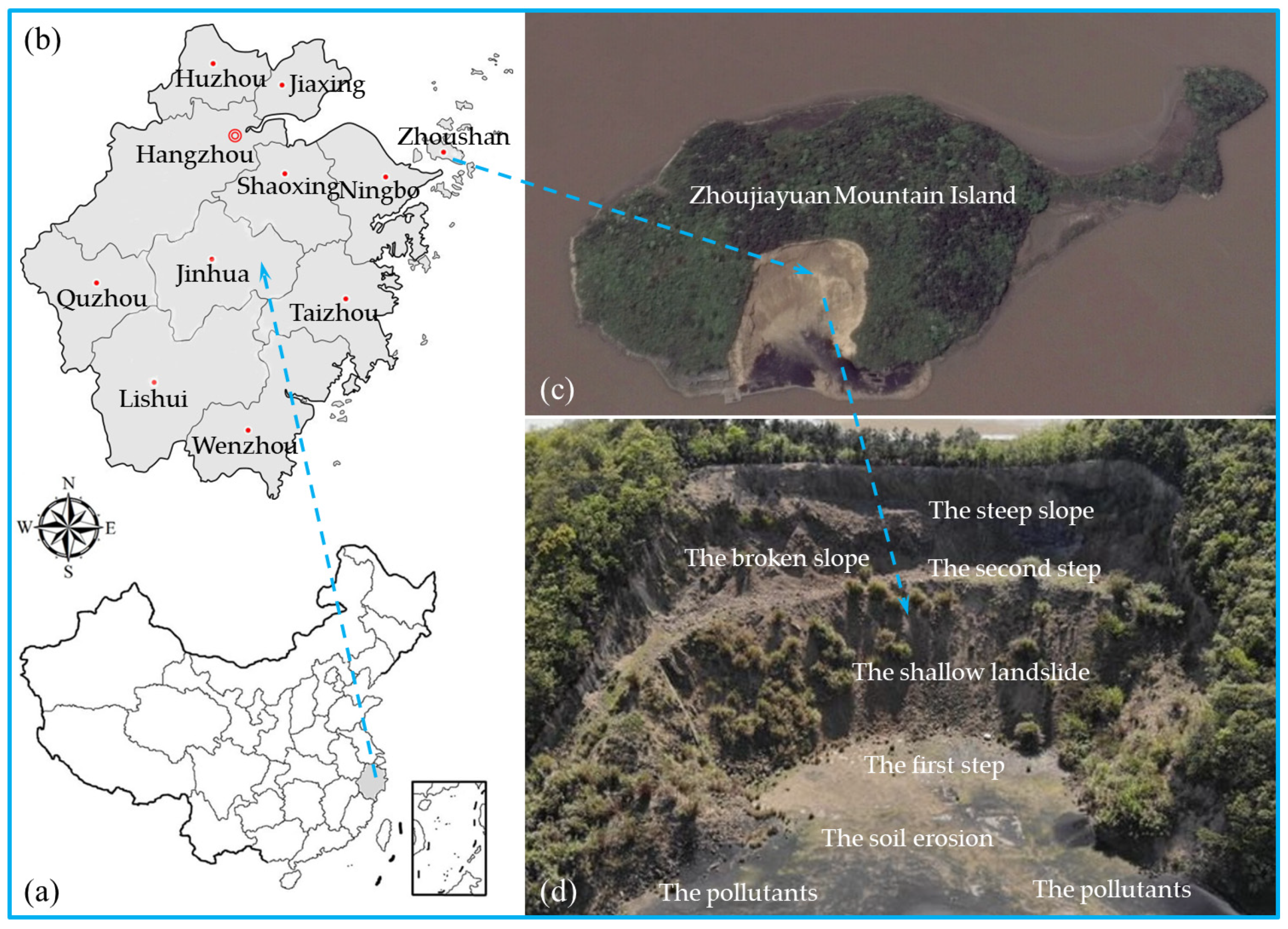

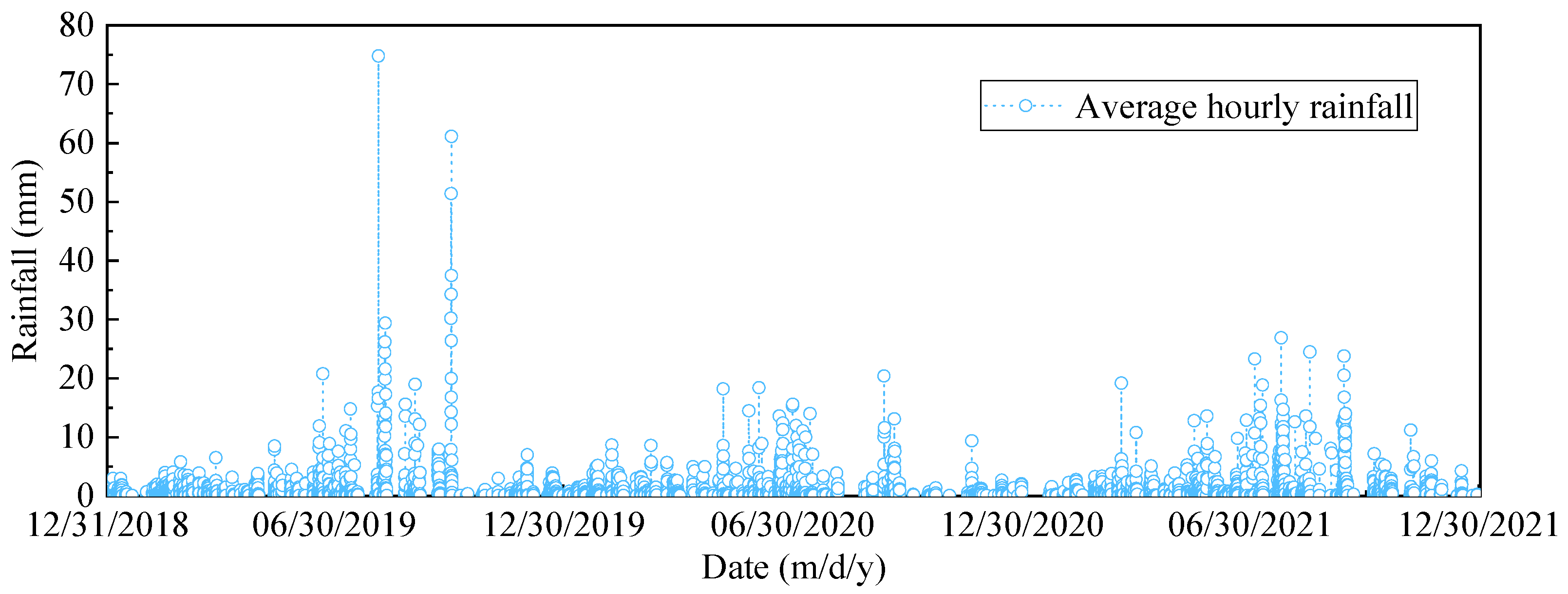


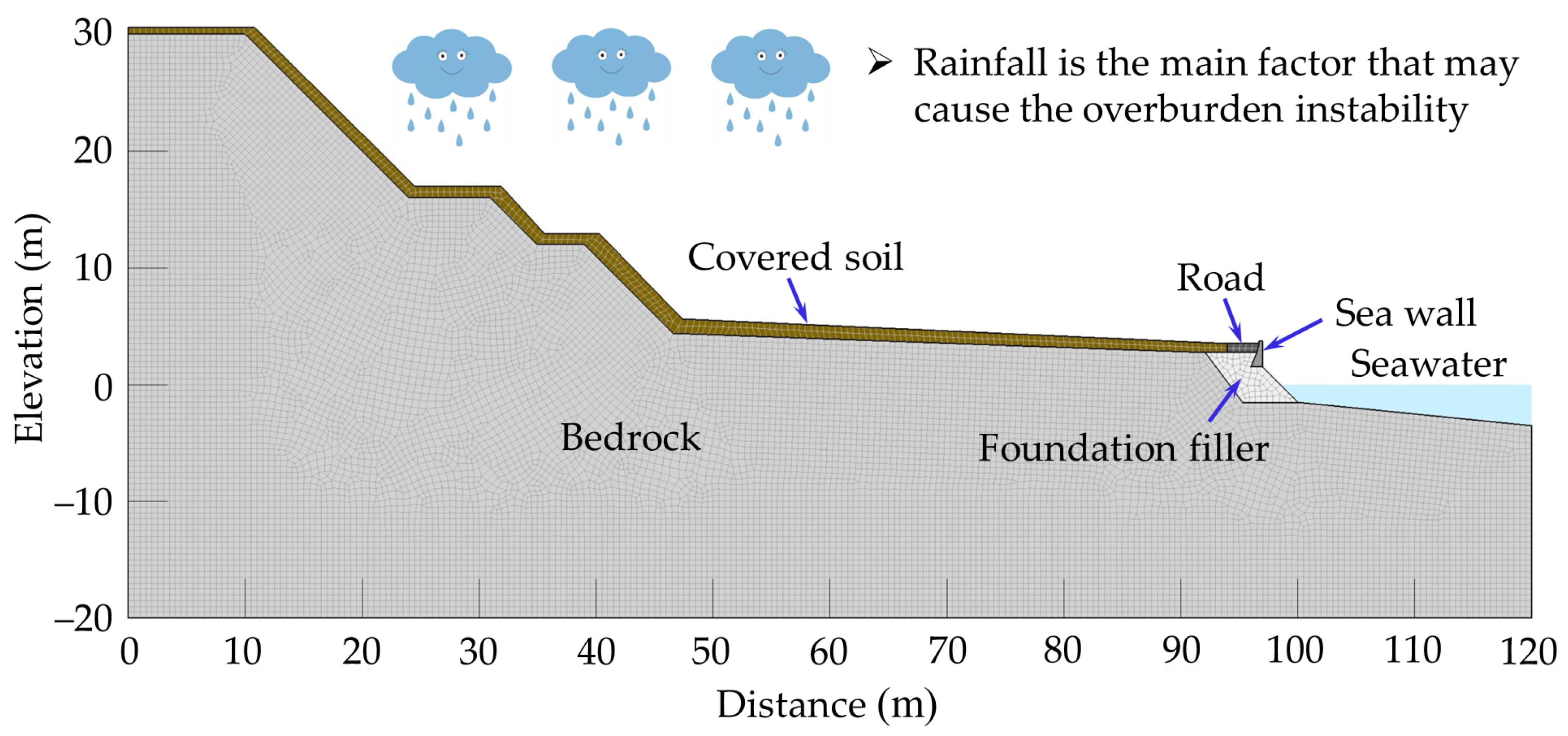
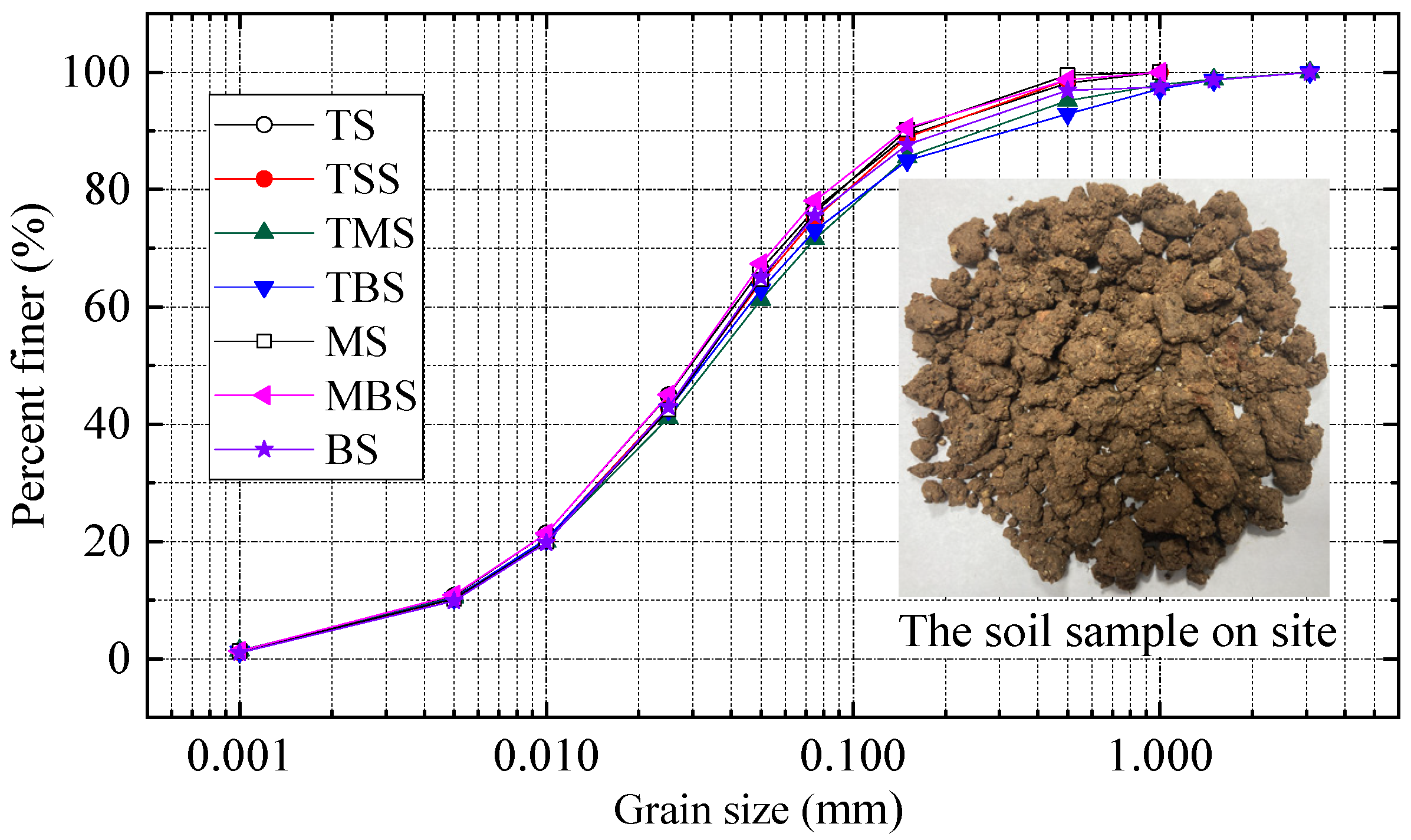

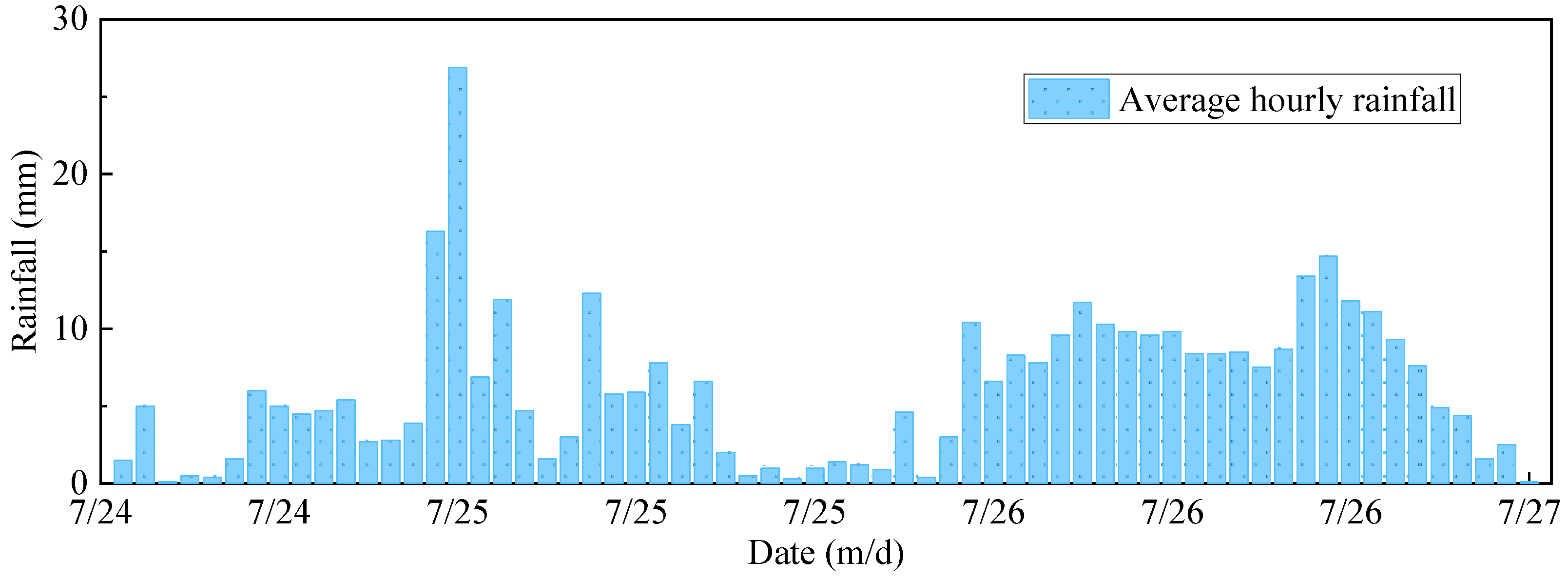
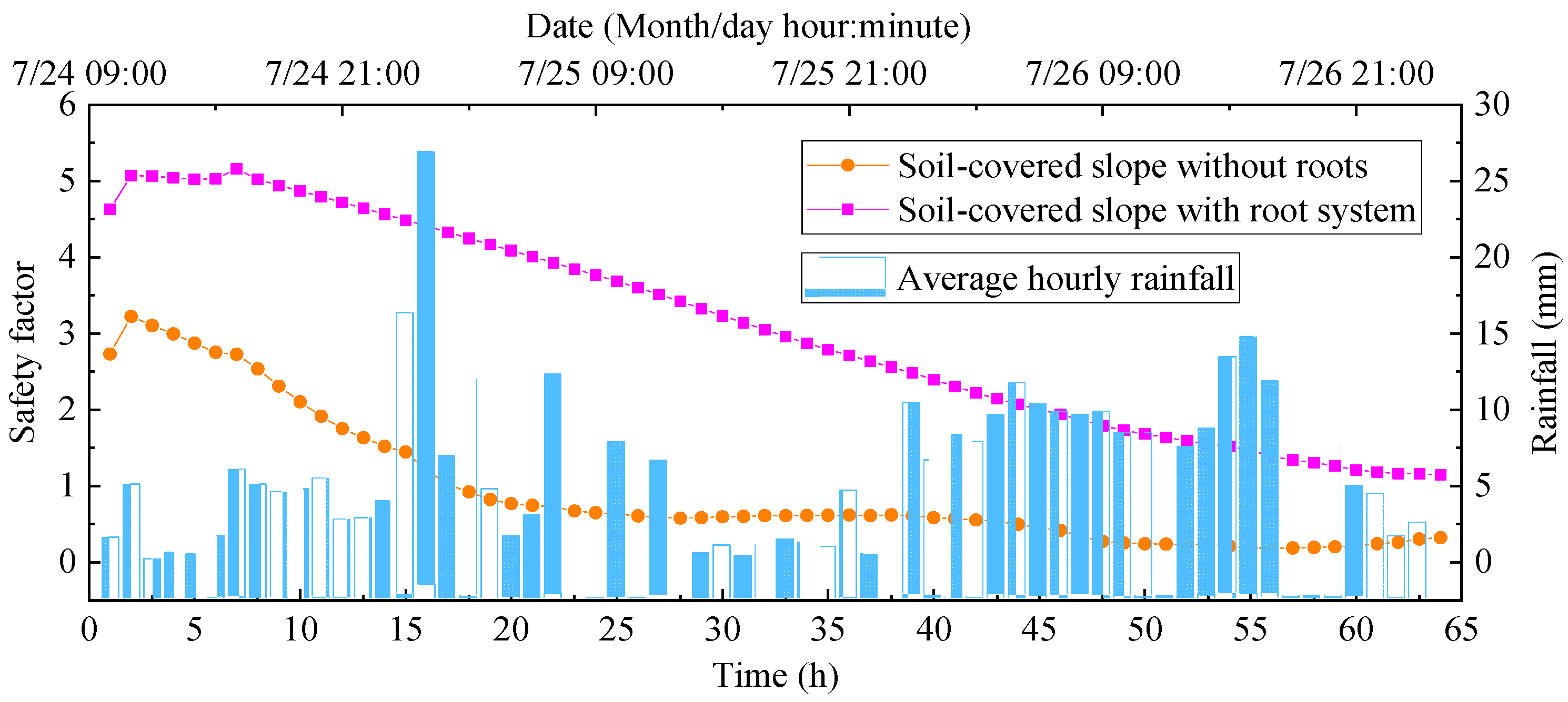
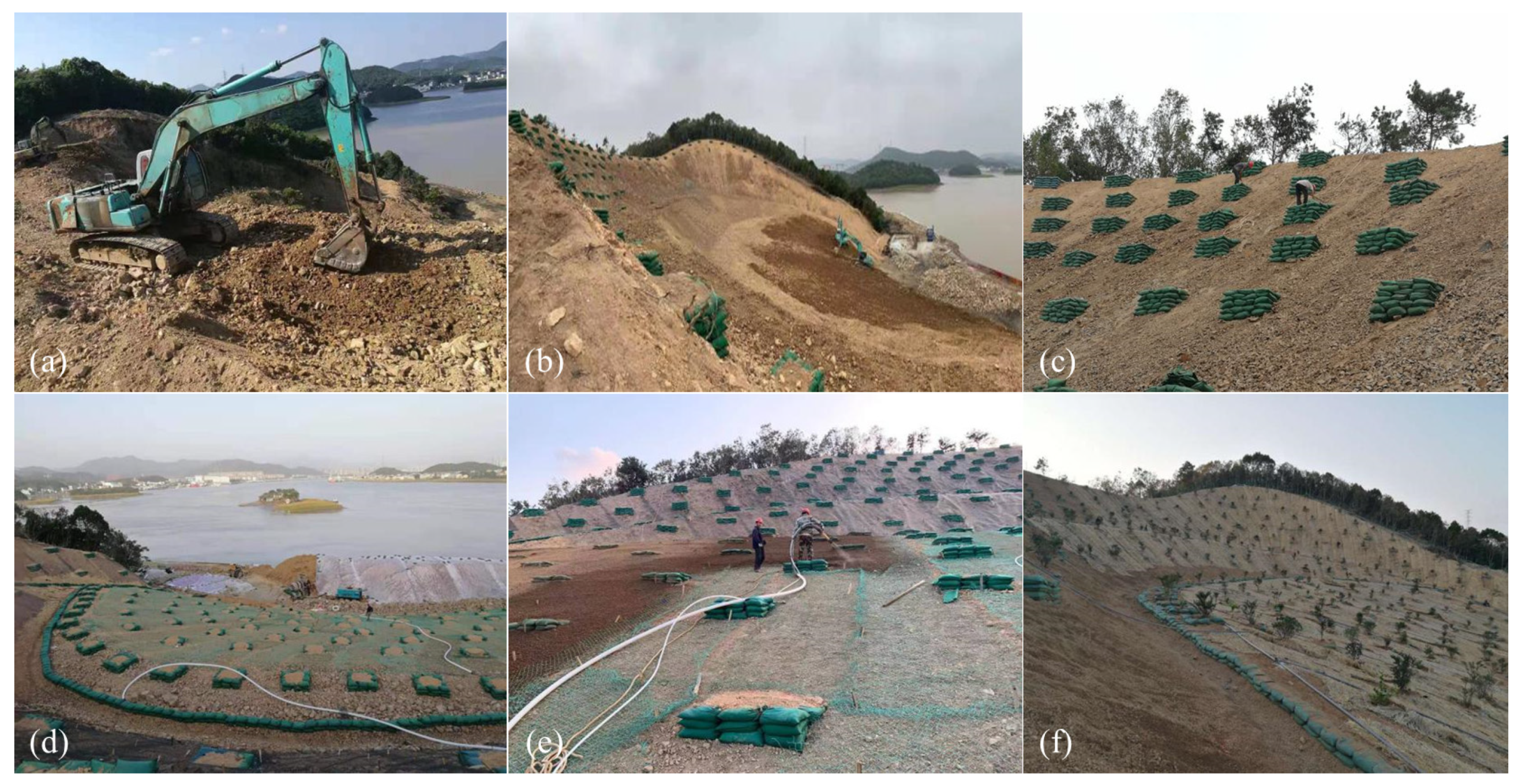
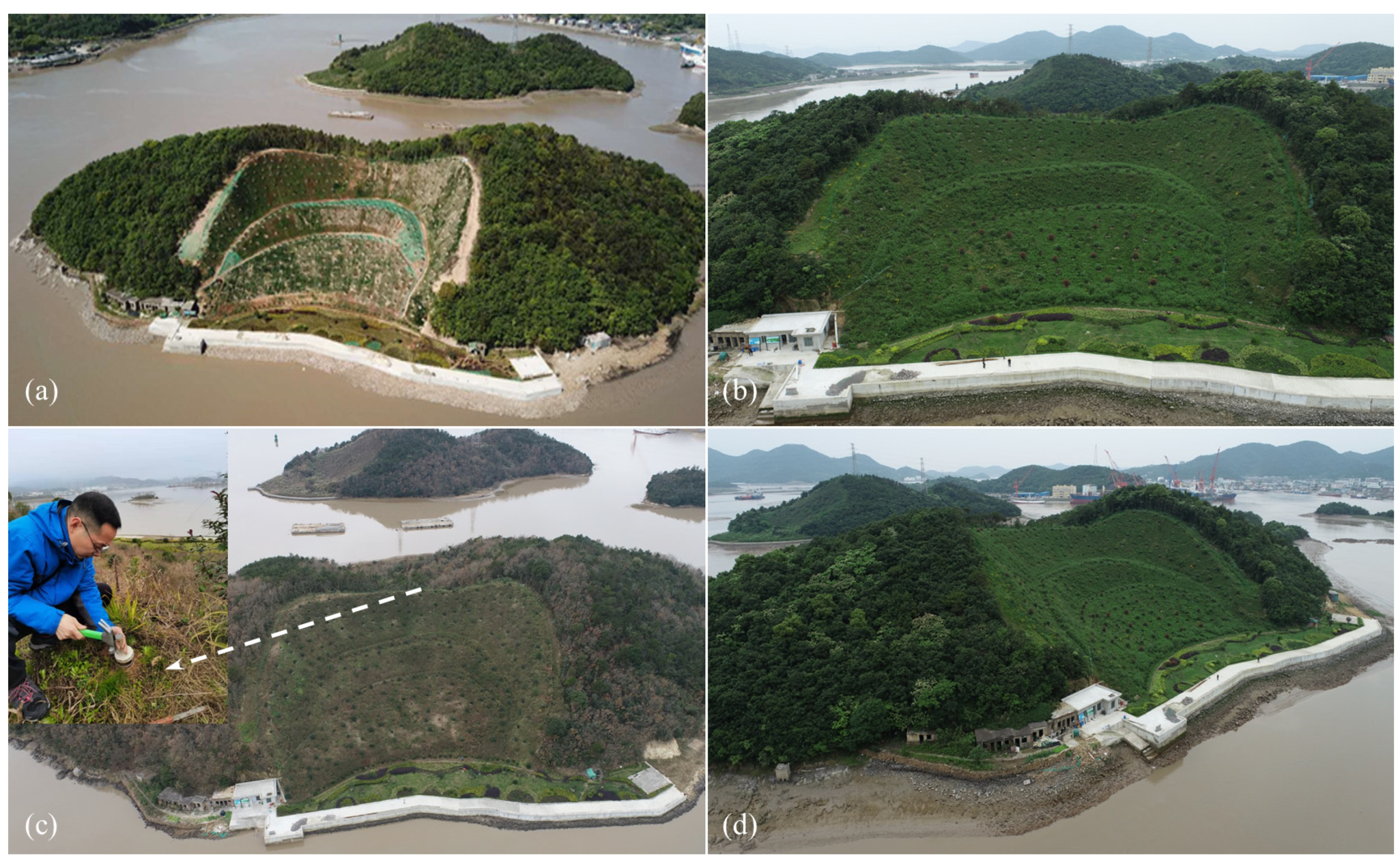
| Zone No. | Overall Tendency (°) | Slope Foot Elevation (m) | Slope Top Elevation (m) | Maximum Slope Height (m) | Slope Below the Second Step (°) | Slope Above the Second Step (°) | Dangerous Rock Volume (m3) |
|---|---|---|---|---|---|---|---|
| A | 350–10 | 3 | 8–30 | 27 | 40–50 | 75 (Nearly upright or even inverted) | 150 |
| B | 50–70 | 3 | 30–33 | 30 | 45–50 | 50–75 (Nearly vertical) | 180 |
| C | 160–180 | 3 | 7–32 | 29 | 45–50 | 50–75 (Nearly vertical) | 110 |
| Zone No. | Main Joint I | Main Joint II | Main Joint III |
|---|---|---|---|
| A | 50° ∠ 40°, Relatively developed, flat, closed–slightly open | 340° ∠ 70°, Relatively developed, flat, closed–slightly open | 200° ∠ 30°, Relatively developed, flat and closed |
| B | 45° ∠ 30°, Relatively developed with a flat surface and long extension | 240° ∠ 65°, Relatively developed with a spacing of 30–60 cm, closed–slightly open | 340° ∠ 70°, Relatively developed, flat, closed–slightly open |
| C | 55° ∠ 45°, Relatively developed with a flat surface and long extension | 240° ∠ 65°, Relatively developed with a spacing of 30–60 cm, closed–slightly open | 200° ∠ 30°, Relatively developed, flat and closed |
| No. | Seed Designation | Quality Requirement (%) | Mass Percentage (%) |
|---|---|---|---|
| 1 | Tall fescue | Purity ≥ 90, Germination percentage ≥ 85 | 28.57 |
| 2 | Bahia grass | Purity ≥ 90, Germination percentage ≥ 85 | 14.29 |
| 3 | Bermuda root | Purity ≥ 90, Germination percentage ≥ 85 | 2.86 |
| 4 | Alfalfa | Purity ≥ 90, Germination percentage ≥ 85 | 2.86 |
| 5 | Desert false indigo | Purity ≥ 80, Germination percentage ≥ 75 | 8.57 |
| 6 | Bush clovers | Purity ≥ 80, Germination percentage ≥ 75 | 8.57 |
| 7 | Hippophae rhamnoides | Purity ≥ 80, Germination percentage ≥ 75 | 14.29 |
| 8 | Indigofera amblyantha | Purity ≥ 80, Germination percentage ≥ 75 | 14.29 |
| 9 | Wild flower combination | Diversity combination | 5.70 |
| Ingredients | Soil | Peat Soil | Grass Fiber | Livestock Manure | Fertilizer | Water Retaining Agent | Adhesive | Seeds |
|---|---|---|---|---|---|---|---|---|
| Percentage (%) | 89.9000 | 0.9900 | 4.0885 | 5.0000 | 0.0050 | 0.0100 | 0.0040 | 0.0025 |
| Material Designation | Effective Cohesion | Effective Internal | Compression | ||
|---|---|---|---|---|---|
| Covered soil | 1.43 | 11.7 | 16.8 | 6.67 | 0.34 |
| Rooted soil | 1.48 | 21.9 | 26.3 | 17.98 | 0.34 |
| Bedrock | 2.68 | 750.0 | 65.0 | 6.00 × 104 | 0.23 |
| Subgrade fill | 1.92 | 2.0 | 25.0 | 32.00 | 0.30 |
| Concrete seawall | 2.40 | 5.0 | 37.0 | 3.30 × 104 | 0.24 |
| Sand, gravel, and block stone foundation | 2.30 | 0.0 | 45.0 | 1.00 × 103 | 0.29 |
| Material Designation | Covered Soil | Rooted Soil | Bedrock | Subgrade Fill | Concrete Seawall | Sand Gravel and Block Stone Foundation |
|---|---|---|---|---|---|---|
| Saturated seepage coefficient (m/s) | 1.60 × 10−5 | 2.19 × 10−6 | 5.24 × 10−9 | 1.22 × 10−4 | 4.50 × 10−7 | 3.26 × 10−3 |
Publisher’s Note: MDPI stays neutral with regard to jurisdictional claims in published maps and institutional affiliations. |
© 2022 by the authors. Licensee MDPI, Basel, Switzerland. This article is an open access article distributed under the terms and conditions of the Creative Commons Attribution (CC BY) license (https://creativecommons.org/licenses/by/4.0/).
Share and Cite
Li, X.; Qin, Z.; Tian, Y.; Zhang, H.; Zhao, H.; Shen, J.; Shao, W.; Jiang, G.; Guo, X.; Zhang, J. Study on Stability and Ecological Restoration of Soil-Covered Rocky Slope of an Abandoned Mine on an Island in Rainy Regions. Sustainability 2022, 14, 12959. https://doi.org/10.3390/su142012959
Li X, Qin Z, Tian Y, Zhang H, Zhao H, Shen J, Shao W, Jiang G, Guo X, Zhang J. Study on Stability and Ecological Restoration of Soil-Covered Rocky Slope of an Abandoned Mine on an Island in Rainy Regions. Sustainability. 2022; 14(20):12959. https://doi.org/10.3390/su142012959
Chicago/Turabian StyleLi, Xiaoyan, Zipeng Qin, Yan Tian, Hongwei Zhang, Haitao Zhao, Jiafa Shen, Weilong Shao, Guangrong Jiang, Xianding Guo, and Junsuo Zhang. 2022. "Study on Stability and Ecological Restoration of Soil-Covered Rocky Slope of an Abandoned Mine on an Island in Rainy Regions" Sustainability 14, no. 20: 12959. https://doi.org/10.3390/su142012959






